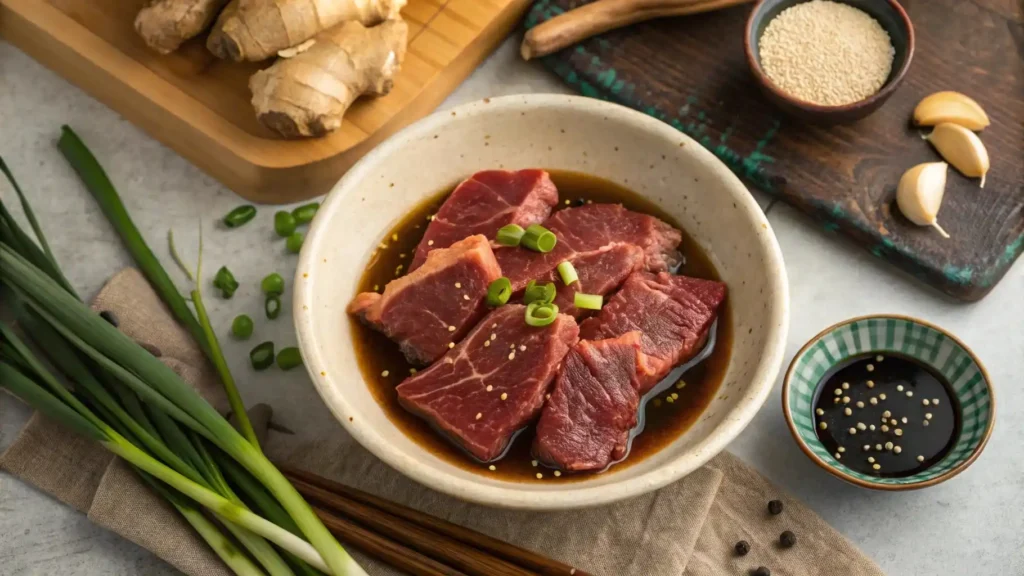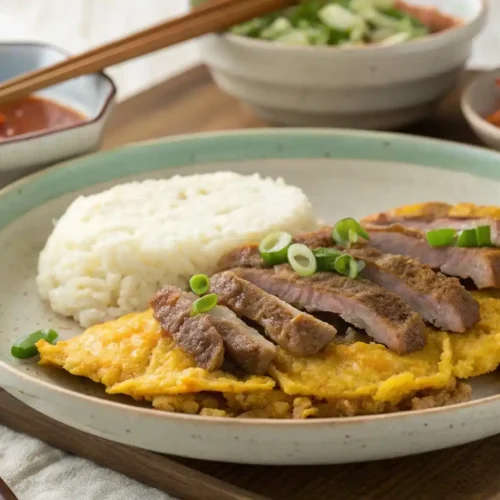Introduction to Meat Jun
Origins and Cultural Significance of Meat Jun
Meat jun is a Hawaiian adaptation of the traditional Korean dish soegogi-jeon. While jeon refers to battered and pan-fried food in Korean cuisine, meat jun became a unique dish in Hawaii, enjoyed as part of the local plate lunch culture. This fusion dish embodies the blend of Korean flavors with Hawaiian dining traditions, making it a beloved staple in many households and restaurants.
Popularity of Meat Jun in Hawaiian Cuisine
Hawaiians have embraced meat jun as a comfort food, often served with rice, mac salad, and a tangy dipping sauce. Not only is the dish commonly found in local eateries, but it also reflects Hawaii’s multicultural influences. Moreover, many home cooks have adapted the recipe to suit personal tastes, further diversifying its preparation methods.
Understanding the Ingredients
Choosing the Right Cut of Beef for Meat Jun
Selecting the right cut of beef is crucial for making tender and flavorful meat jun. Typically, thinly sliced cuts such as ribeye, sirloin, or cross rib work best as they absorb the marinade well and cook quickly.
Essential Components of the Marinade
The marinade typically consists of soy sauce, sugar, sesame oil, garlic, and sometimes ginger. Consequently, this combination infuses the meat with a sweet-savory flavor that enhances its taste once fried.
Role of Flour and Egg in the Battering Process
Dredging the marinated beef in flour and egg before frying creates the crispy, golden exterior characteristic of meat jun. In particular, the flour helps the egg adhere better, forming a light yet flavorful coating.
Step-by-Step Meat Jun Recipe

Preparing the Marinade
To make the perfect meat jun marinade, mix the following ingredients:
- 1/4 cup soy sauce
- 1 tablespoon sugar
- 1 teaspoon sesame oil
- 2 cloves minced garlic
- 1/2 teaspoon grated ginger (optional) As a result, marinating thinly sliced beef for at least 30 minutes, or up to overnight, will allow for a deeper flavor.
Marinating the Beef: Techniques and Timing
Proper marination ensures the meat soaks up the flavors. Therefore, refrigerating the beef in the marinade for optimal absorption, flipping occasionally to coat all sides evenly, is recommended.
Battering and Frying: Achieving the Perfect Texture
- First, dredge each slice of beef in flour, shaking off excess.
- Next, dip in beaten eggs, ensuring an even coat.
- Finally, fry in a pan with medium-hot oil until golden brown on both sides.
Serving Suggestions and Presentation Tips
Serve meat jun with steamed rice, kimchi, or a side salad. Additionally, garnishing with sesame seeds and chopped green onions adds extra flair.
Variations and Adaptations of Meat Jun
Exploring Protein Alternatives: Chicken and Fish Jun
For a twist on traditional meat jun, chicken breast or white fish can be used in place of beef. Likewise, following the same marinade and battering process ensures a delicious outcome.
Vegetarian Twist: Tofu Jun
For a vegetarian option, firm tofu can be marinated and fried using the same method. Consequently, this offers a delicious meat-free alternative.

Classic Korean Meat Jun Recipe
Equipment
- Large mixing bowl For marinating the beef
- Non-stick frying pan For cooking the Meat Jun
- Whisk For mixing the egg batter
Ingredients
- 1 lb lb Flank steak or ribeye Thinly sliced best cut for Meat Jun
- 1/4 cup cup Soy sauce For the marinade
- 2 tbsp tbsp Sugar Adds sweetness to the marinade
- 2tbsp tbsp Sesame oil For flavor
- 3 cloves cloves Garlic minced Adds aroma
- 1/4 tsp tsp Black pepper For seasoning
- 4 Eggs For the egg batter
- 1/4 cup cup All-purpose flour For coating the beef
- 2 tbsp tbsp Vegetable oil For frying
Instructions
- Marinate the Beef:
- In a large mixing bowl, combine soy sauce, sugar, sesame oil, minced garlic, and black pepper. Add the thinly sliced beef and mix well. Cover and refrigerate for at least 1 hour.
- Prepare the Egg Batter:
- In a shallow dish, whisk the eggs until well-beaten. Set aside.
- Coat the Beef:
- Lightly dust each slice of marinated beef with flour, shaking off any excess.
- Dip in Egg Batter:
- Dip the floured beef slices into the beaten eggs, ensuring they are fully coated.
- Cook the Meat Jun:
- Heat vegetable oil in a non-stick frying pan over medium heat. Add the beef slices in a single layer and cook for 2-3 minutes on each side, or until golden brown and crispy.
Notes
- For a gluten-free version, substitute soy sauce with tamari and all-purpose flour with rice flour.
- Meat Jun is best served immediately but can be reheated in a skillet to maintain crispiness.
- Pair with steamed rice, kimchi, and a simple salad for a complete meal.
Frequently Asked Questions about Meat Jun
Meat jun sauce is typically a mix of soy sauce, rice vinegar, sugar, sesame oil, and sometimes chili flakes or garlic for extra depth.
Ribeye, sirloin, or cross rib are the preferred choices due to their tenderness and flavor absorption. Furthermore, thin slicing helps achieve the best texture.
Meat jun pairs well with rice, mac salad, kimchi, or a simple cucumber salad. In addition, dipping sauces can enhance the flavors.
While inspired by Korean jeon, meat jun is considered a Hawaiian adaptation rather than a traditional Korean dish. As a result, it is more commonly found in Hawaii than in Korea.
Nutritional Information and Dietary Considerations
Caloric and Macronutrient Breakdown of Meat Jun
A typical serving of meat jun is high in protein but also contains fats from frying. Consequently, lighter versions can be made using leaner cuts and minimal oil.
Adapting Meat Jun for Health-Conscious Diets
To make a healthier meat jun, consider air frying instead of deep frying. Additionally, using a lower-sodium marinade can help reduce overall sodium intake.
Cooking Tips and Common Mistakes to Avoid

Ensuring Even Cooking and Preventing Overcrowding
Fry meat jun in small batches to avoid lowering the oil temperature. Otherwise, overcrowding can result in a soggy batter instead of a crispy texture.
Avoiding Common Pitfalls in Meat Jun Preparation
Common mistakes include over-marinating, which can make the beef too salty, and using excessive flour, which can lead to a dense batter. To prevent these issues, follow precise measurements and cooking times.
Meat Jun in Modern Cuisine: Fusion and Innovation
Creative Takes on Traditional Meat Jun
Meat jun can be reinvented in dishes like tacos, sliders, or even sushi rolls for a unique twist. Moreover, experimenting with different proteins and seasonings can create new variations.
Meat Jun in Restaurants and Food Trucks
Popular in Hawaii, meat jun is commonly found in food trucks and casual dining spots. In fact, many chefs offer different interpretations of the classic recipe, making it an exciting dish to try in various settings.
Conclusion: Embracing the Legacy of Meat Jun
Reflecting on the Cultural Impact of Meat Jun
Meat jun represents the rich culinary fusion of Korean and Hawaiian cultures, making it a dish cherished by many. Therefore, it holds significant cultural value in both regions.
Encouraging Home Cooks to Preserve and Innovate
By experimenting with variations and serving styles, home cooks can enjoy and pass down this delicious dish to future generations. Ultimately, this ensures that meat jun remains a beloved part of Hawaiian cuisine.

